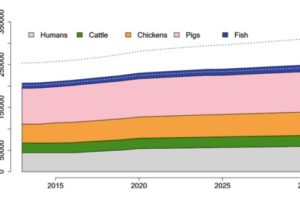Special Issue 4: Antimicrobial Use in Agriculture
Key points:
- The global rise in demand for animal protein is among the salient changes of our time. Animals raised for human consumption constitute nearly 60% of the total mammalian biomass on the planet, and poultry makes up more than 90% of the avian biomass.
- Antimicrobial consumption in animals is nearly triple that of humans and is a primary driver of the scale-up in animal protein production. Since 2000, meat production has reached a plateau in high- income countries but has grown by 64%, 53%, and 66% in Asia, Africa, and South America, respectively.
- Research from CDDEP and collaborators found that in 2013, the global consumption of all antimicrobials in food animals was 131,109 tons and is projected to reach 200,235 tons by 2030. Consumption levels varied considerably between countries, ranging from 8 mg/PCU in Norway to 318 mg/PCU in China– the world’s largest consumer of veterinary antimicrobials.
- Moreover, aquaculture consumption is increasing at a rate even faster than meat and dairy consumption. Globally, aquaculture contributes 8% of animal protein intake to the human diet. Global antimicrobial use in the rapidly expanding aquaculture industry has been estimated at 10,259 tons in 2017 and is projected to increase by a third to 13,600 tons in 2030. Please see the figure below.
- Global antimicrobial consumption in aquaculture is concentrated in the Asia-Pacific region, at more than 93%, with China alone contributing 57.9% of global consumption in 2017.
Background: This report presents updated data from around the world and summarizing recent research. The two tools are now available: the Drug Resistance Index (DRI), which measures the average effectiveness of the antibiotics used to treat a given bacterial infection and the Country Dashboards, which show the status of antibiotic resistance and use in humans and animals across 40 countries.

Figure 7: Global antimicrobial consumption, 2013–2030. Dotted lines represent the 95% uncertainty interval for antimicrobial consumption estimates in fish. Source: Schar, D., Klein, E. Y., Laxminarayan, R., Gilbert, M. & Van Boeckel, T. P. Global trends in antimicrobial use in aquaculture. Sci. Rep. 10, 21878 (2020).
CDDEP, 3 February 2021


 Report
Report
